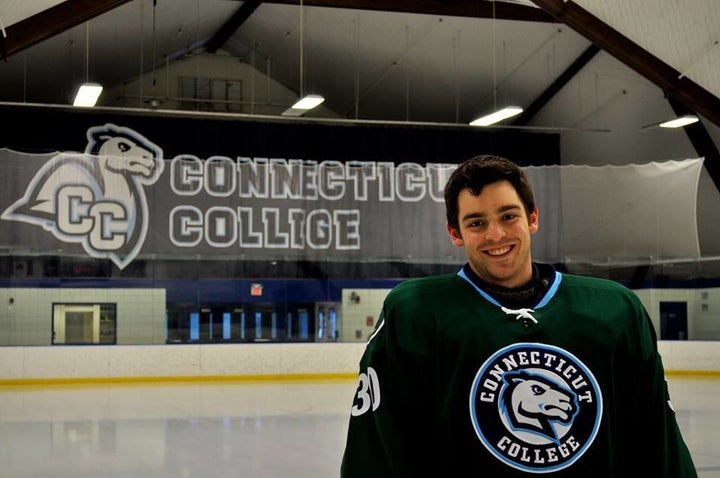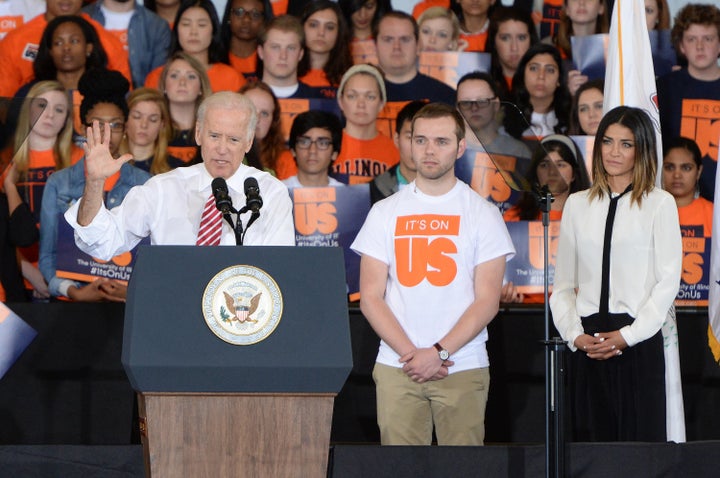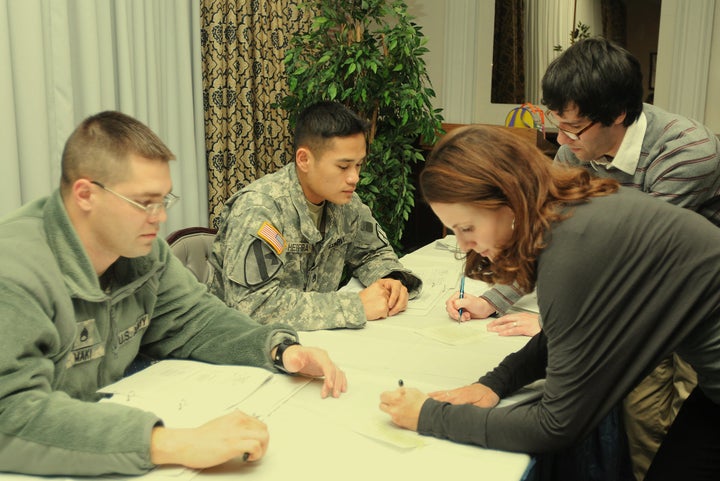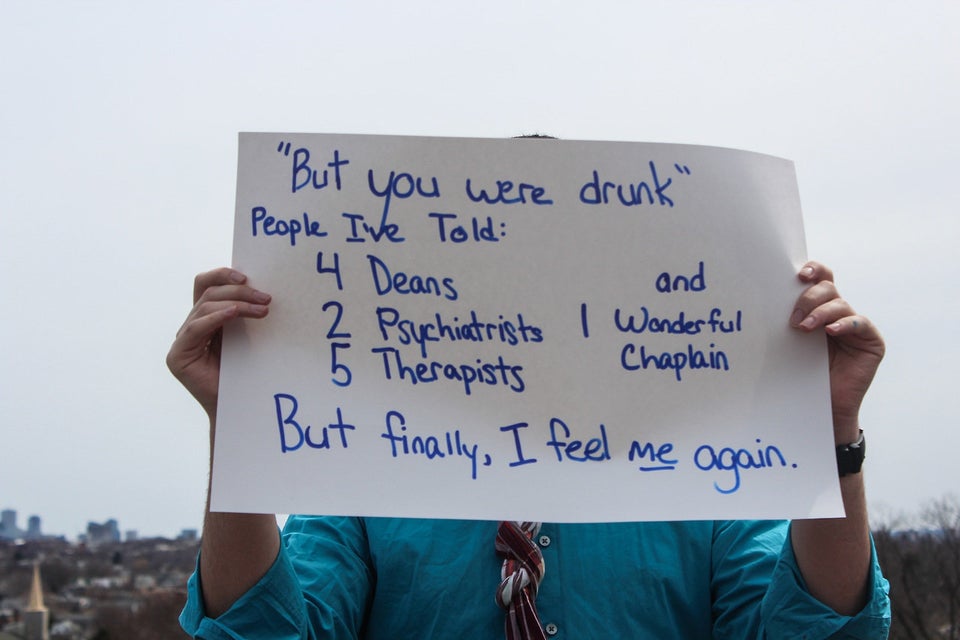When it comes to one of the nation's most widely-used college sexual assault prevention programs, Greg Liautaud lives its teachings, literally.
A junior at Connecticut College, Liautaud and sophomore Matt Gaetz have made themselves the resident Green Dot counselors in their campus apartment building, unofficially training their neighbors how to step in whenever they witness situations that could lead to assault.
Green Dot is one of the bystander intervention programs that hundreds of colleges across the country are using to combat sexual violence. If people spot a guy at a party who may be bothering or taking advantage of someone, the thinking goes, they can interrupt the situation and then stop the potential assailant's momentum -- preventing a sexual assault from happening. No one even needs to utter the word "rape."
"You step in like that and it kind of just ends the situation," Liautaud explained. "It's not really about calling someone a bad person, it's just defusing the situation."
That's the appeal of bystander intervention programs like Green Dot, experts say. Rather than treating everyone as a potential rapist or rape victim, students are treated like allies who are empowered to step in. And according to research, it's working: For example, John Foubert, who received a grant from the Department of Education to study the impact of bystander intervention, found in 2007 that fraternity men who were trained in bystander intervention were 40 percent less likely to commit sexual violence.
Liautaud and Gaetz, who both play on their school's men's hockey team, say Green Dot training has become standard for them and their teammates. No one is formally required to go through the training, but with so much buy-in on the team and around campus, the athletes do it anyway. The team's fifth annual Green Dot-themed hockey game on Saturday drew the largest crowd of the season, with 500 attendees -- more than double the typical amount.
After five years, Green Dot is as much a part of life for the hockey team as practice. "Even new players are coming into a culture that's set in stone," Gaetz said. "It's almost better that they embrace it on their own."

When The Status Quo Isn't Working
For decades, two messages were used to stop campus rape. For women, that meant being warned to carry mace and travel in groups to avoid being assaulted. Men were told what the law was so they wouldn't get in trouble. In short, you were either a potential victim or a perpetrator, and it didn't work.
Rates of sexual violence on college campuses have remained steady since the 1980s. Today, many activists and experts in the prevention field think "No means no" lectures are a waste of time and energy.
"The guys will say, 'Well, I'm not going to perpetrate, and my job is done,'" said Jessy Lyons, associate director at Green Dot. "Talking to women as potential victims of violence has not had any more success."
As colleges nationwide come under heightened scrutiny for how they address sexual assault, bystander intervention has emerged as a favorite strategy for preventing rape on campus. It's noncontroversial, gender-neutral and provides hope that students can prevent other people from engaging in bad behavior. And perhaps just as importantly, the White House is heavily promoting it.
Bystander intervention serves as the basis for the White House's "It's On Us" campaign, which teaches people how to identify a scenario that could lead to sexual violence so they can stop to it.
"It's On Us" gave a big bump to bystander intervention in 2014, but Vice President Joe Biden actually began promoting the program in 2011. The latest reauthorization of the Violence Against Women Act also included a mandate for more rape prevention programming for college students and staff, giving schools another reason to adopt bystander intervention.
Lyons believes it's more effective than "No means no" lectures. "Now we're talking to all of you as allies to the solution," she said.
Tom Conlin, a senior on the Connecticut College hockey team, describes learning about three strategies in Green Dot: using a distraction to pause the situation, delegating intervention to someone else, or directly intervening in a situation.
Conlin considers himself a "distracter," and so does Liautaud. "That's pretty much everyone's go-to -- it's kind of the easiest," Liautaud said, describing how he might distract someone by inviting them to join him for french fries, mozzarella sticks or some sort of other greasy food to prevent a situation from escalating into sexual assault.

The Groups Behind Bystander Intervention
Green Dot, developed at the University of Kentucky, is one of the two largest nonprofits deploying anti-rape bystander intervention programs on college campuses. The other is Bringing in the Bystander, created at the University of New Hampshire. Staff for both programs typically teach campus facilitators how to lead bystander intervention workshops that can last between one to six hours.
"We don't tell them you have to use the program as it is off the shelf," said Sharyn Potter, co-director of UNH's Prevention Innovations Research Center. "We want them to use examples that are campus-specific." That means using slang like "wicked" in Boston, or referring to specific party spots on a particular campus.
Close to 300 colleges have implemented Green Dot training in the past few years. Bringing in the Bystander is being used at more than 400 schools in 43 states as well as the U.S. military, and is going international.
More than 440 colleges and universities are also using Step Up!, a bystander intervention program created by the University of Arizona that focuses on other challenges on campus, like depression and excess drinking, as well as sexual assault.
Some schools have started their own bystander intervention programs as well. The University of North Carolina's program is called One Act. The Claremont Colleges consortium has developed an abridged version of Green Dot called Teal Dot. Many student leaders were required to attend one of Teal Dot's three-hour training sessions in September 2015, and more sessions are planned for spring 2016.
Teal Dot is one leg of the consortium's sexual assault prevention efforts, said David Oxtoby, president of Pomona College, one of the Claremont schools.
"I do read campus safety reports," Oxtoby said, "and one of the sorts of things I see is not just about sexual assault -- a student reporting a concern, seeing two people together, and calling campus safety or calling deans in to see what's going on. It might not be a sexual assault issue, it might be another conflict, but I'm seeing students doing that because they're told it's a good thing to do."
The limitations, Oxtoby said, are that not every sexual assault has a clear warning sign, and there's not a bystander in every room.
Other programs, like Mentors in Violence Prevention and the Men’s Project, offer bystander intervention programs for schools while also exploring issues like masculinity. With the help of grants from the Department of Education, MVP started in the mid-1990s by teaching athletes about bystander intervention and combatting sexism and homophobia.
Foubert started the prevention program One in Four in the 1990s with a mission to teach men to empathize about what it would be like to be raped. That way, he said, "they would be in position to support someone who comes to them in the event of a sexual assault, and two, they would hopefully be less likely to do it if they know the effect."
In 1998, Foubert published a book to promote his program and put it in the public domain so any campus could adopt it. "I found, pretty conclusively, if you're going to get men to understand rape, you have to get them to understand what it's like to be a survivor on their own," he said.
Some campuses have employed multiple programs. The University of Virginia, for example, hosts Green Dot and Step Up! trainings and has a campus chapter of One in Four.

The Case For Picking Your Battles
Part of the reason that bystander intervention programs have achieved so much buy-in in higher education seems to be that they largely avoid the "third rails" of rape prevention: like telling students not to drink too much or to avoid casual hookups. The message is gender-neutral, doesn't lecture students about drinking, and recognizes that a majority of assaults happen between acquaintances, not strangers in dark alleys.
Lyons, from Green Dot, argues that addressing overarching issues like masculinity, sexism or gender dynamics is a long-term effort best left out of bystander intervention workshops.
"Norms around gender and sexuality -- those norms take a long time to change. Meanwhile, people are getting sexually assaulted every day on a college campus," she said.
"If I walk into a freshman orientation and say, 'Stop using the word bitch,' and put all of these components of rape culture in there, I end up losing a lot of people," Lyons said. "They'll agree with me that rape and sexual assault need to be stopped, but a lot of them are not going to agree with me that sexist jokes are a big deal -- and if I put those two together, they're going to throw it out."
It's more effective to work on moving the needle in the right direction, "one person, one act at a time," argued Becky Bell, creator and founder of Step Up!
"This stuff isn't easy; the issues we face are complex" Bell said. "This is not a cookie-cutter approach, it's something that really takes time and effort and investment. One presentation for one hour is not going to change a culture."
“"If I walk into a freshman orientation and say, 'Stop using the word bitch,' and put all of these components of rape culture in there, I end up losing a lot of people."”
- Jessy Lyons of Green Dot
Rape victim advocates are much more supportive of bystander intervention training than other efforts universities have tried, like art projects or short online quizzes.
But some say the training will be for naught if there isn't also an effort to address sexist and hyper-masculine behaviors.
"Ideally, I'd love for all colleges to have some sort of mandatory intro-level course about rape culture," said Julia Michels, a recent graduate who was the president of a campus feminist group at the University of Mary Washington in Fredericksburg, Virginia.
Nick Favaloro, a University of Virginia student who leads bystander intervention trainings, said they can also help change culture. They are "laying the groundwork" for that broader shift, he said.
One in Four's Foubert just wants to use whichever approach the data shows to be effective.
"I'm one for focusing on a limited set of objectives and doing them well, as opposed to trying to do too much in too little time and having no effect on anything," he said.
What The Data Says
Data is a big component of bystander intervention programs -- at least the ones run by nonprofits, which rely on the work of academics and researchers to determine which strategies work best.
Multiple peer-reviewed studies of Bringing in the Bystander found that students and military men who participated in the program's workshops were more likely to intervene in situations that could lead to sexual violence without receiving backlash. A peer-reviewed evaluation of Green Dot in 2014 showed that students who went through the training were less likely to be victims of sexual assault or perpetrate it. Men who went through Green Dot training were one-third less likely to commit sexual harassment.
One study published in 2013 reviewing the impact of multiple bystander intervention programs found that participants were more likely to intervene, less accepting of rape myths and less likely to be sexually aggressive or commit sexual violence, even if they believed they wouldn't get caught.
Yet even if bystander intervention programs show promise in getting people to intervene before an assault happens, there is limited evidence so far that they actually prevent people from perpetrating.
A 2014 study in the journal Aggression and Violent Behavior argued that because men are more likely to commit an assault in high school or early in college, prevention efforts should really focus on boys who are younger than 18. The analysis identifies only two programs that actually prevent young men from perpetrating sexual violence, and both of them target middle school students.
Some experts have also commented recently that we are lacking research about perpetrators on campus, and called for a greater focus on those who commit assaults.
Jane Stapleton, co-director of Bringing In The Bystander, said intervention programs can stop sexual violence and relationship abuse by engaging community members to create an environment in which a victim will come forward.
But, she added, it's just as important for administrators to understand there is no single program that's going to solve the issue of sexual assault.
"You also need to have policies to hold perpetrators accountable, you need services for survivors," Stapleton said. "Don't treat bystander intervention as if that's going to make the problem of campus rape go away."

Tyler Kingkade covers higher education and sexual violence, and is based in New York. You can reach him at tyler.kingkade@huffingtonpost.com, or find him on Twitter: @tylerkingkade.
Related Coverage:
- We Know One Way To Stop Sexual Assault, But Students Aren't Doing It
- There's No More Denying Campus Rape Is A Problem. This Study Proves It.
- How A Stanford Student Accused Of Assaulting Multiple Women Graduated
- Columbia Students Reveal How The University Dragged Out Sexual Assault Investigations
- Why Even Small, Progressive Grinnell College Has Trouble Dealing With Sexual Assault On Campus
- How Rolling Stone's UVA Story Sparked A Controversial Frat Lobbying Effort
Also On HuffPost:

